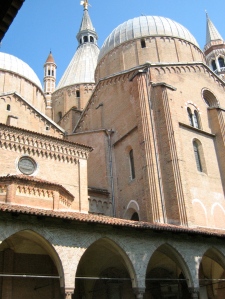 Fernando Martins de Bulhões, venerated as Anthony of Padua or Anthony of Lisbon, (c. 1195 [1] – 13 June 1231) is a Portuguese Catholic saint who was born in Lisbon, Portugal where he lived most of his life, to a wealthy family and who died in Padua, Italy.Fernando Martins de Bulhões, who later, upon admission into the Franciscan Order, would take up the name António (Anthony), was born in Lisbon to Martim Vicente de Bulhões and Teresa Pais Taveira (brother of Pedro Martins de Bulhões, ancestor of the Bulhão or Bulhões family), in a very rich family of the nobility who wanted him to become educated; however, these were not his wishes. His family arranged sound education for him at the local cathedral school. Against the wishes of his family, he entered the Augustinian Abbey of St. Vincent on the outskirts of Lisbon. The Canons Regular of St. Augustine, of which he was a member, were famous for their dedication to scholarly pursuits. Anthony studied Scripture and the Latin classics.
Fernando Martins de Bulhões, venerated as Anthony of Padua or Anthony of Lisbon, (c. 1195 [1] – 13 June 1231) is a Portuguese Catholic saint who was born in Lisbon, Portugal where he lived most of his life, to a wealthy family and who died in Padua, Italy.Fernando Martins de Bulhões, who later, upon admission into the Franciscan Order, would take up the name António (Anthony), was born in Lisbon to Martim Vicente de Bulhões and Teresa Pais Taveira (brother of Pedro Martins de Bulhões, ancestor of the Bulhão or Bulhões family), in a very rich family of the nobility who wanted him to become educated; however, these were not his wishes. His family arranged sound education for him at the local cathedral school. Against the wishes of his family, he entered the Augustinian Abbey of St. Vincent on the outskirts of Lisbon. The Canons Regular of St. Augustine, of which he was a member, were famous for their dedication to scholarly pursuits. Anthony studied Scripture and the Latin classics.Welcome to the Basilica of our Saint here in Padua.
The friars of Saint Anthony’s shrine have decided to establish a site where news and information is made available to all those who would like to know more about the place where the body of the Saint which the world loves has been guarded for almost 8 centuries.
I am sure you will appreciate the contents of this site, especially if you are about to organize a pilgrimage to our Basilica. It is possible to check timetables and reserve the celebration of a Mass for your group. Choirs desiring to sing during Mass on week days or holidays will find an application form.
I am sure you will appreciate the «virtual tour » offered in this site. It’s not the real thing, you will say, and we agree with you. It is for this reason that we hope to see you personally here in Padua.
 The Basilica of Saint Anthony of Padua (Italian: Sant'Antonio di Padova) is a church in Padua, northern Italy. Although the Basilica is visited as a place of pilgrimage by people from all over the world, it is not the titular cathedral of the city, a title belonging to the Duomo. The basilica is known locally as "il Santo".
The Basilica of Saint Anthony of Padua (Italian: Sant'Antonio di Padova) is a church in Padua, northern Italy. Although the Basilica is visited as a place of pilgrimage by people from all over the world, it is not the titular cathedral of the city, a title belonging to the Duomo. The basilica is known locally as "il Santo".Construction of the Basilica probably began around 1235, nineteen years after the death of St. Anthony. It was completed in 1301 although several structural modifications (including the falling of the ambulatory and the construction of a new choir screen) took place between the end of the 14th and the mid 15th century. The Saint, according to his will, had been buried in the small church of Santa Maria Mater Domini, probably dating from the late 12th century and near which a convent was founded by him in 1229. This church was incorporated into the present basilica as the Cappella della Madonna Mora (Chapel of the Dark Madonna).



